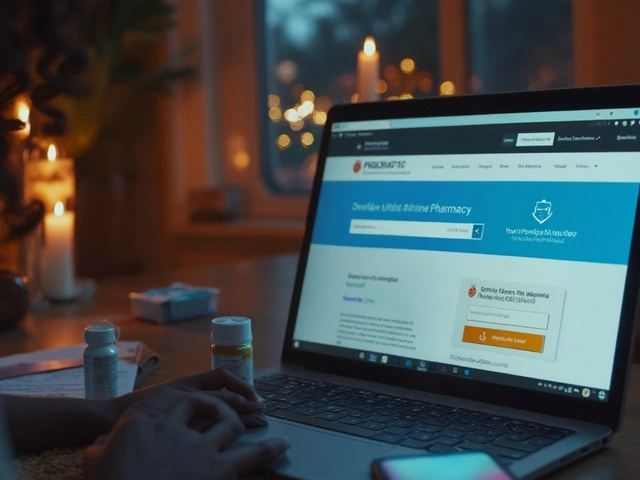Ticlopidine is an oral antiplatelet drug used to reduce the risk of blood clots after certain heart procedures. While it’s great at preventing clots, some patients report persistent headaches as a side effect. If you’ve been prescribed ticlopidine and find yourself reaching for painkillers more often than you’d like, this guide offers practical, evidence‑based ways to keep the pounding at bay.
What Triggers a Ticlopidine‑Induced Headache?
Understanding why the headache starts makes it easier to treat. Ticlopidine interferes with platelet aggregation by blocking the ADP receptor on platelets. This action can also affect blood vessel tone, leading to vasodilation that some people experience as a throbbing head pain. In addition, the drug is metabolized by the liver enzyme CYP2C19 a common enzyme that processes many medications. Variations in CYP2C19 activity can cause higher blood levels of ticlopidine, increasing the likelihood of side effects, including headaches.
Quick Checklist: Spotting a Ticlopidine Headache
- Starts within a few days to weeks after beginning therapy.
- Feels like a dull, pressure‑type ache or a pulsing migraine‑style pain.
- Often worsens with physical exertion or sudden changes in posture.
- May be accompanied by mild nausea, light sensitivity, or neck tension.
If you notice these signs, you’re probably dealing with a ticlopidine‑related issue rather than an unrelated tension headache.
Immediate Self‑Care Strategies
Before you call your doctor, try these low‑risk measures that can cut the pain in half for many users.
- Hydration: Dehydration narrows blood vessels, amplifying headache pain. Aim for at least 2 L (about 8 cups) of water daily. Adding a pinch of sea salt can help retain fluids.
- Limit Caffeine: While a modest coffee can constrict vessels and lessen pain, too much caffeine may trigger rebound headaches. Stick to 1‑2 cups per day.
- Regular Meals: Low blood sugar can mimic headache symptoms. Eat balanced meals with protein, complex carbs, and healthy fats every 4-5 hours.
- Gentle Stretching: Neck and shoulder tension often accompany drug‑induced headaches. Perform a simple 5‑minute neck roll and shoulder shrug routine each morning.
- Cold or Warm Compress: Apply a cool pack to the forehead for 15 minutes or a warm towel to the neck, depending on which feels soothing.

Choosing the Right Over‑the‑Counter Relief
When self‑care isn’t enough, non‑prescription painkillers can step in. Not all work the same way, and some interact with ticlopidine.
| Medication | Active Ingredient | Mechanism | Interaction Risk |
|---|---|---|---|
| Acetaminophen | Paracetamol | Inhibits central COX enzymes, reduces pain signals | Low - safe with ticlopidine |
| Ibuprofen | NSAID | Blocks peripheral COX‑1/COX‑2, reduces inflammation | Moderate - may increase bleeding risk |
| Aspirin | Acetylsalicylic acid | Irreversibly inhibits platelet COX‑1 | High - additive antiplatelet effect |
For most ticlopidine patients, acetaminophen offers effective pain relief without raising bleeding risk. If inflammation is a big factor, a short course of ibuprofen (max 600 mg every 6 hours) can be used, but discuss duration with your physician.
When to Consider Switching Antiplatelet Therapy
If headaches persist despite the steps above, a medication change may be warranted. Two commonly used alternatives are Clopidogrel another ADP‑receptor blocker with a lower headache profile and Aspirin the classic antiplatelet agent that’s often paired with low‑dose anticoagulants. Here’s a quick side‑by‑side look:
| Drug | Typical Dose | Common Side Effects | Headache Incidence |
|---|---|---|---|
| Ticlopidine | 250 mg twice daily | Neutropenia, rash, GI upset | ~12 % |
| Clopidogrel | 75 mg once daily | Bleeding, mild GI upset | ~4 % |
| Aspirin | 81 mg daily (low‑dose) | Bleeding, stomach irritation | ~5 % |
Switching should always be overseen by a cardiologist or prescribing physician, especially if you have a history of cardiovascular disease conditions like coronary artery disease or peripheral artery disease.
Medical Interventions for Persistent Pain
When headaches become chronic (more than three days a week) or severe (rating 8/10+), your doctor may prescribe targeted treatments:
- Triptans - useful if the headache has migraine features; low interaction risk.
- Beta‑blockers - some patients find prophylactic doses reduce both blood pressure and headache frequency.
- Prescription‑strength NSAIDs - may be needed for short bursts, but monitor platelet counts.
- Dosage adjustment - lowering ticlopidine to 250 mg once daily can cut side effects without losing efficacy for many.
Regular blood work to watch for neutropenia (a rare but serious ticlopidine complication) is also recommended.

Red Flags: When to Call Your Doctor Immediately
Headaches are common, but certain accompanying signs signal a more serious problem:
- Sudden, severe “thunderclap” headache.
- Vision changes, slurred speech, or weakness.
- Fever, neck stiffness, or rash.
- Bleeding gums or unusual bruising (possible over‑anticoagulation).
If any of these appear, seek emergency care - they could indicate a stroke, meningitis, or severe bleeding.
Frequently Asked Questions
Can I stop ticlopidine on my own if headaches are unbearable?
No. Stopping abruptly can raise clot‑formation risk. Talk to your prescriber first; they may taper the dose or switch drugs safely.
Is it safe to combine acetaminophen with ticlopidine?
Yes. Acetaminophen does not affect platelet function and is the preferred OTC option for mild‑to‑moderate pain.
Why do some people get headaches while others don’t?
Genetic differences in the CYP2C19 enzyme, baseline migraine history, hydration status, and concurrent meds all influence individual susceptibility.
Can lifestyle changes replace medication?
Lifestyle tweaks can lessen severity but they don’t remove the clot‑prevention benefit. Continue the drug unless a doctor advises otherwise.
Is there a link between ticlopidine and migraine?
Research shows a modest increase in migraine‑like episodes, especially in patients with a prior migraine history. Switching to clopidogrel often reduces this risk.
Bottom Line
Managing ticlopidine‑induced headaches boils down to three core actions: stay hydrated, choose low‑risk pain relief, and keep an open line with your healthcare team. With the right mix of self‑care and professional guidance, most users can keep their heads clear while still protecting their heart.
ticlopidine headache management doesn’t have to be a guessing game-follow these steps, monitor your symptoms, and you’ll be on the road to relief.





Carla Taylor
October 24, 2025 AT 15:35Staying hydrated really helps keep those ticlopidine headaches at bay and it’s easy to fit into a daily routine. Try sipping water throughout the day instead of chugging it all at once. Adding a pinch of sea salt can make the fluids stay longer and you’ll feel the difference quickly.
Kathryn Rude
October 24, 2025 AT 18:22One must consider that the article glosses over the pharmacokinetic nuances while parroting generic advice. The oversight reflects a broader trend of complacent health writing 🙂.
Ekeh Lynda
October 24, 2025 AT 21:08The article attempts to simplify a complex pharmacological interaction but fails to address the heterogeneity of CYP2C19 polymorphisms across populations. It assumes a uniform metabolic response which is biologically inaccurate. Individual variability influences drug plasma concentrations and therefore the incidence of side effects. Moreover the recommendation to increase salt intake overlooks hypertensive risk in susceptible cohorts. The suggested water intake of two liters is presented without accounting for renal function variability. A blanket statement about caffeine limits ignores tolerance differences among regular consumers. The table comparing OTC analgesics does not cite primary sources or clinical trial data. Readers are left without a quantitative risk assessment for bleeding versus analgesic efficacy. The suggestion to switch to clopidogrel lacks discussion of its own metabolic pathway involving CYP2C19. Failure to mention potential drug‑drug interactions with common statins is a glaring omission. The emphasis on hydration as a panacea is overly simplistic and dismisses the role of electrolyte balance. The article also neglects to advise on monitoring platelet counts during long‑term therapy. While the lifestyle modifications are sound in principle, the guidance is presented without an evidence hierarchy. The red‑flag symptoms are correctly identified but the urgency phrasing could be refined. Overall the piece provides a cursory overview that would benefit from deeper mechanistic insight and citations. Readers seeking actionable guidance should consult their cardiologist for personalized assessment.
Marilyn Pientka
October 24, 2025 AT 23:55The ethical imperative to avoid adverse drug interactions mandates rigorous adherence to evidence‑based analgesic selection, particularly when anticoagulant pathways are implicated. Empirical data underscore that acetaminophen comprises a low‑risk analgesic profile, thereby aligning with the principle of primum non nocere whilst preserving antiplatelet efficacy.
Jordan Levine
October 25, 2025 AT 02:42THIS IS WHAT HAPPENS WHEN YOU IGNORE THE SIMPLE FACTS – HEADACHES THAT KEEP YOU FROM LIVING THE AMERICAN DREAM! 😡 STOP SNIFFING THE MEDS AND GET SOME WATER, YOU’LL FEEL BETTER FAST. 🚀
Lindy Hadebe
October 25, 2025 AT 05:28The tips are fairly generic and don’t add much beyond standard advice. It feels like filler content rather than a targeted solution.
Mary Mundane
October 25, 2025 AT 08:15Acetaminophen is indeed the safest OTC choice here.
Michelle Capes
October 25, 2025 AT 11:02i totally get how frustrating those pounding headaches can be 🙁 staying hydrated and eating regular meals really does help a lot. have you tried a warm compress on your neck after a short walk? sometimes a gentle stretch before bed makes the difference. keep track of your symptoms and let your doctor know if they get worse.
Dahmir Dennis
October 25, 2025 AT 13:48It is amusing how often patients accept medication side effects as unavoidable destiny, as if the pharmaceutical industry holds a monopoly on truth. One could argue that personal responsibility for lifestyle choices should precede the prescription of another chemical agent. Yet the naïve trust placed in a pill without scrutinizing its pharmacodynamics is a cultural tragedy. The article’s emphasis on hydration, while valid, borders on the platitudinous. If we truly adhered to evidence‑based practice, we would demand rigorous post‑marketing surveillance data before accepting headaches as a minor inconvenience. So, before you blame ticlopidine, consider whether you have been neglecting the fundamentals of self‑care.